Abstract
Response surface methodology was used to investigate the influence of three factors, sourdough fermentation time, proof time and amount of yeast addition on the quality of sourdough wheat bread. Each predictor variable was tested at five levels. Sourdough fermentation times were 5, 11, 20, 29 and 35 h, yeast addition rates were 0.05, 0.75, 1.77, 2.80 and 3.50% (flour weight basis) and proof times were 16, 40, 75, 110 and 134 min. The performance of two different starter culture types, a mixed strain starter culture called Böcker Reinzucht–Sauerteig Weizen and a single strain starter culture of Lactobacillus brevis, was compared by separately completing the experimental design for each. Independently non-acidified control bread was prepared. A range of loaf quality parameters was determined including pH, total titratable acidity, loaf height, specific volume, crumb mean cell area and crumb hardness. Overall breads with better specific volume values were achieved with the use of sourdough relative to the control. Results indicated that maximum loaf specific volume was achieved when L. brevis sourdough was used particularly when it was used in conjunction with a high rate of yeast. Given a lower rate of yeast addition however, the mixed strain starter culture yielded better bread.






Similar content being viewed by others
References
Röcken W, Voysey PA (1995) J Appl Bacteriol Symp Suppl 79:38S–48S
Hammes WP, Gänzle MG (1998) Sourdough breads and related products. In Wood BJB (ed) Microbiology of fermented foods, vol. 1, 2nd edn. Blackie, London, pp 199–216
Stear CA (1990) Handbook of breadmaking technology. Elsevier, London
Brümmer J-M, Lorenz K (1991) Cereal Foods World 36:310–314
Corsetti A, Gobbetti M, De Marco B, Balestrieri F, Paoletti F, Russi L, Rossi J (2000) J Agric Food Chem 48:3044–3051
Thiele C, Gänzle MG, Vogel RF (2002) Cereal Chem 79:45–51
Salovaara H, Göransson M (1983) Näringsforskning 27:97–101
Larsson M, Sandberg A-S (1991) J Cereal Sci 14:141–149
Liljeberg H, Björck I (1994) Eur J Clin Nutr 48:151–64
Liljeberg HGM, Lönner CH, Björck IME (1995) J Nutr 125:1503–1511
Lavermicocca P, Valerio F, Evidente A, Lazzaroni S, Corsetti A, Gobbetti M (2000) Appl Envir Microbiol 66:4084–4090
Magnusson J, Schnürer J (2001) Appl Envir Microbiol 67:1–5
Wehrle K, Grau H, Arendt EK (1997) Cereal Chem 74:739–744
Gobbetti M, Corsetti A, Rossi J (1995) World J Microbiol 11:625–630
Gan Z, van der Graaf J, Leonard SA, Brooker BE, Parker ML, Schofield (1999) The role of wheat proteins and polar lipids in the stabilisation of the foam structure of dough. In Campbell GM, Webb C, Pandiella SS, Niranjan K (eds) Bubbles in food. Eagan Press, St Paul, Minn., pp 89–93
Shah P, Campbell GM, Dale C, Rudder A (1999) Modelling bubble growth during proving of bread dough: predicting the output from the Chopin rheofermentometer. In Campbell GM, Webb C, Pandiella SS, Niranjan K (eds) Bubbles in food. Eagan Press, St Paul, Minn., pp 95–106
Baker JC, Mize MD (1937) Cereal Chem 14:721–734
van Vliet T (1999) Physical factors determining gas cell stability in a dough during bread making. In Campbell GM, Webb C, Pandiella SS, Niranjan K (eds) Bubbles in food. Eagan Press, St Paul, Minn., pp 121–127
Wiggins C (1998) Proving, baking and cooling. In Cauvain SP, Young LS (eds) Technology of breadmaking. Blackie, London, pp 120–148
Barber S, Báguena R, Benedito de Barber C, Martínez-Anaya MC (1991) Z Lebensm Unters Forsch 192:46–52
Clarke CI, Schober TJ, Arendt EK. (2002) Cereal Chem 79:640–647
Bloksma A H (1990) Cereal Foods World 35:228–236
Box GEP, Wilson KB (1951) J R Stat Soc Ser B Methodol 13:145
Myers RH, Montgomery DC (1995) Response surface methodology. Wiley, New York
Arbeitsgemeinschaft Getreideforschung e.V. (AGF) (1994) Standard-Methoden für Getreide, Mehl und Brot. 7 überarbeitete und erweiterte Auflage. Verlag Moritz Schäfer, Detmold, Germany (ISBN 3-87696-103-4)
International Association for Cereal Science and Technology (ICC) (1996) ICC Standard Methods, 6th Suppl/edn 1996. ICC Standard No. 115/1, approved: 1972, revised: 1992. Verlag Moritz Schäfer, Detmold, Germany
Crowley P, Schober TJ, Clarke CI, Arendt EK (2002) Eur Food Res Technol 214:489–496
Bourne MC (1978) Food Technol 32:62–66, 72
Crowley P, Grau H, Arendt EK (2000) Cereal Chem 77:370–375
Finney KF (1943) Cereal Chem 20:381–396
Lookhart GL (1997) Cereal Foods World 42:16–19
Kawamura Y, Yonezawa D (1982) Agric Biol Chem 46:767–773
Cauvain SP (1998) Bread the product. In Cauvain SP, Young LS (eds) Technology of breadmaking. Blackie, London, p 117
Maleki M, Hoseney RC, Mattern PJ (1980) Cereal Chem 57:138–140
Cauvain SP, Whitworth MB, Alava JM (1999) The evolution of bubble structure in bread doughs and its effect on bread structure. In Campbell GM, Webb C, Pandiella SS, Niranjan K (eds) Bubbles in food. Eagan Press, St Paul, Minn., pp 85–88
Acknowledgements
This project was funded by the Irish government under the National Development Plan, 2000–2006. The authors gratefully acknowledge Dr. Colm O'Brien for his assistance with the experimental design and statistical analysis.
Author information
Authors and Affiliations
Corresponding author
Rights and permissions
About this article
Cite this article
Clarke, C.I., Schober, T.J., Angst, E. et al. Use of response surface methodology to investigate the effects of processing conditions on sourdough wheat bread quality. Eur Food Res Technol 217, 23–33 (2003). https://doi.org/10.1007/s00217-003-0724-1
Received:
Published:
Issue Date:
DOI: https://doi.org/10.1007/s00217-003-0724-1




